|
Biblical Archaeo-Astronomy of the Ancient Egyptian Star Names of the Dendera zodiac
Psalm 96:4 -5 For the Lord is Great and greatly to be praised: He is to be feared above all gods. For all the gods of the nations are idols, but the Lord made the heavens.
The ancient zodiac found in the Temple of Hathor at Dendera, Egypt, known as the Dendera zodiac, has provided a revealing view of the significance of the goddess Hathor and the rituals associated with her temple in ancient Egypt. However, its true import from the viewpoint of the history of ancient Astronomy, far exceeds heathen rituals associated this idol goddess, linked with the goddess Isis in ancient Egypt. There is archaeological evidence showing a shrine at Dendera dedicated to Hathor, as early as the Pre-dynastic period from 5500 BC-3100BC. It was the work of Sir Norman Lockyer who initially described how the singular temples of ancient Egypt were utilized as monumental astronomical instruments oriented towards specific celestial bodies. For example, he found that the Temple of Amon-Ra at Karnak was accurately oriented towards the summer Solstice, and the high precision applied by the astronomers of ancient Egyptian allowed them to calculate the length of their year to within 4 points of the decimal, or [365.2422]. Conventional Archaeology has taken note that the temple to Hathor was rebuilt during the Pyramid Age by the Pharaoh Khufu (2589-2566BC). There is more evidence that pharaohs of the Middle Kingdom Dynasties, Menuhotep (2004-1992BC), and Amenemhat (1985-1955BC) made additions or inscriptions on Hathor's temple. Also during the New Kingdom Dynasties of Tuthmosis III (1479-1425BC), Amenhoptep III (1390-1352BC) and Rameses II (1279-1213BC), these pharaohs also rebuilt or paid homage to Hathor/Isis at this location. But not until Lockyer came along, did anyone realize that many of these ancient temples in Egypt changed their axis of orientation to match the shifting position of a particular star, to which certain temples were dedicated in their star religion.
The building located at Dendera today was erected during the Graeco-Roman Period (332BC-395AD). Archaeologists believe that construction of the current shrine began during the reign of Ptolemy XII (80-51BC) and was abandoned during the First Century AD. Our interest is in the study of the astronomical practices of the ancient Egyptians associated with the Temple at Dendera, and what these practices can tell us about the sophistication of their knowledge of Astronomy at such an early time. This knowledge comes from two primary areas, first the zodiac of Dendera itself, originally found on the ceiling of the shrine, reflecting a map of the sky with Constellations divided into 36 decans, used in Egypt to divide the 12 hours of the night.
The Dendera zodiac is depicted in Figure A below.
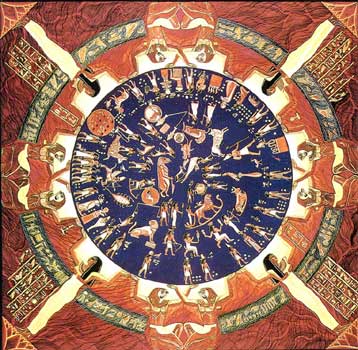
Secondly, we are interested in the use of the Sothic Calendar in ancient Egypt, which was prominently connected with the rituals conducted annually at Hathor's Temple. The most important rite was the New Year's festival, when Hathor's statue was taken in a procession to the roof of the shrine, so she could be ceremonially unified with the light rays of the Sun-god. The context of this rite, was the alignment of the luni-solar calendar based on the Heliacal Rising of the star Sirius. Hathor's celestial aspect was seen in the star Sirius. As E.C. Krupp states: "Isis as Sirius was the mother of the New Year. Isis in her way, then, also reestablished the world order by creating the New Year as she rose heliacally in the form of Sirius."1
On New Year's day every year, the statues of the Sun-god (Ra) and Hathor/Isis were carried to the roof of the shrine, where the light of both Sirius and the Sun would shine on them. According to Krupp: "the Heliacal Rising of Sirius involves only a brief appearing of the star before it is lost in the light of the sun. The event of this union, or marriage, recreates the world order by celebrating the sun's birthday, the New Year."2 [emphasis mine]
The significance of the coordination of the lunar and solar cycles in the context of this New Year's celebration is that the Heliacal Rising of Sirius signaled the Egyptians to add an Intercalation month to keep the lunar cycles in line with the solar seasons. We have already seen how the history of Hathor's temple extends back into Pre-dynastic ages coincident to the Precessional age of Taurus. We can take note of the recognition of precession in ancient Egypt also in how the Pharaohs took thier names. As we have already seen above, the Menuhopteps, starting with Menes/ Narmer, preceded the Amenhoteps in the Pharonic historical progression. What is interesting is that these Old Kingdom Pharaohs adopted Mentu the Bull into their names during the latter stages of the Precessional Age of Taurus, just before the precessional transiton to the Age of Aries, around 2100 BC. Once the Age of the Ram Aries began, the Pharaohs began honoring the Ram-Amon in their kingly names. During this period and following was also when Ram-headed Criosphinxes began showing up in Egyptian iconagraphy, as a representation of their creator-god Khnum, who they believed, fashioned the universe out of clay. This also explains Khnum's association with the fertility of soil and the annual innundation of the Nile. As Khnum grew in power and influence in the Egyptian pantheon, the symbolism of the Bull became less important. In concert with this viewpoint from a Hathor/ Isis perspective, Egyptologist Richard Parker deciphered early symbols carved on an ivory tablet from the First Dynasty as: "Sirius, the opener of the year, the innundation." As Krupp observes: "This implies that the basic elements of the calendar system were in place by 3100 BC. The same celestial calibrations endure all the way into the Ptolemaic period, 3,000 years later." 3 A First Dynasty Ivory plaque depicts the star Sirius as a hieroglyph of a reclining Cow with the Sun above her head, easily visible in similar form in the Dendera zodiac, marking not only the start of the New Year, but also having precessional significance, since Isis as this reclining cow is found just behind the sign Gemini, in the counter-clockwise order of precessional ages. This is strong evidence of the use of the Sirius cycle, or Sothic Calendar in ancient Egypt, standing as a testimony to their recognition of precession and advanced astronomical practices early on.
Biblically, we can trace the knowledge of precession to at least the time of Kings David and Solomon in Israel, around 1000 BC. This is evident in Scripture in the Psalms of David, which depicts the path of the Sun as a tabernacle of [12] houses, compared to a strong man running a race; [Psalm 19:4-5]. This is a prophecy of the Coming Redeemer written in the heavens. Verse 6 below provides some early evidence of specifics of the depth of technical awareness and sophistication of the celestial science of the ancient Hebrews.
Psalm 19:6
His going forth is from the end of heaven, and his circuit unto the ends of it: and there is nothing hid from the heat thereof.
"going forth"-mowtsa [H4161] in the Hebrew, meaning; "the dawn, the east, a gate, the rising Sun." This is a direct reference to the counter-clockwise precessional motion of the Sun, as it rises at dawn in the east at the vernal equinox in successive "gates" or houses of the zodiac, for periods of 2160 years in each house, also known as a precessional age.
"end of heaven"- here "end" refers to an extremity or border, and in this context, specific solar cycles are being depicted. According to Strongs Concordance; "Heaven" is in the second form, being a dual of an unused singular. Strong's infers that this dual perhaps makes reference to the dual aspect of the sky: first, in the visible arch where the clouds move above our heads, and second, in the higher space where the stars and planets revolve.4 Since the context of this passage has already singled out the latter of these two options, we can observe that this reference is pointing out dual aspects of the solar cycle. This is supported in the following words of this verse:
"his circuit"- tequpah [H8622] is a specific reference to the annual cycle of the solar year, as seen in II Chronicles 24:23, where this word is translated "end of the year." This is also evident in the remaining words in this verse "nothing is hid from the heat thereof." The Sun is our primary source of light and heat on Earth, and as we have already seen, Biblically this light is a three-fold light denoting physical light as our source of biological life, not to mention a connotation for "enlightenment", which includes both intellectual and spiritual knowledge. The light of God in Christ symbolized in the Sun, NOT literalized into the idol of the Sun-god, exposes all darkness and hidden things. Nothing can hide from the Son's effulgent and resplendent light.
This verse provides clear Biblical evidence of both the knowledge of the precession of the equinoxes, and the annual solar cycle in the time of David. Our website study on Noah's Calendar, provides additional evidence of the early application of this knowledge, along with Joseph's dream in Gen. 37. Since Noah and his family were the only survivors of the flood, we can trace all the roots of our modern celestial practices back to him. We have also noted how the Sothic Calendar was known and utilized in the Book of Job, the oldest book in Biblical Canon, and the only Scripture specifically penned to and for the Biblical Patriarchal administration. The influence of the Biblical Patriarchs can be seen and felt in ancient Egypt, which accounts for their advanced celestial knowledge appearing fully formed in the purity of its earliest stages, as opposed to the concepts of the evolutionary "progress model." It is the corrosive decay of Astrology which degraded the original purity of the Astronomy of the Biblical Patriarchs, that we seek to nullify here, utilizing the principles of Biblical Archaeo-Astronomy.
Sirius is thus a key important element of the advanced astronomical knowledge in ancient Egypt involving their practical knowledge of the precession of the equinoxes, due to the extended duration of the Sirius cycle, as opposed to the shorter solar year. The Dendera zodiac provides hard archaeological evidence in unity with the Great Pyramid and the Great Sphinx, that knowledge of the precession was applied in ancient Egypt, long before Hipparchus supposedly "discovered" it around 134 BC. This idea, that the ancient Egyptians were not only aware of precession, but practiced its intricacies based on the symbolism and sacred geometry, built into their temple architecture and star religion, has always been strongly opposed by the evolutionists because, history shows that much of the ancient Egyptian knowledge inherent in their astronomy, hieroglyphics, mathematics and medicine were more advanced in their earliest dynasties than they were later on. Obviously, a sophisticated ancient culture like Egypt with fully developed systems at their inception, flies in the face of "evolutionary progress" starting with the primitives, that humanity ostensibly endured, before man could reach the "pinnacle" of knowledge and wisdom that we hold in modern times. This is the main reason Lockyer's findings were scoffed at and given the silent treatment by evolutionists of his day, yet this evidence still stands defiantly and unaccounted for, by atheistic evolutionists today. As an example, Lockyer believed that the Temple at Dendera was probably "rebuilt at least three times since 3733 BC; once in the reign of King Pepi I, [which Lockyer dates at 3233 BC] once again by Thothmes III in 1600 BC, and finally by the Ptolemies about 100 BC. According to Lockyer the temple may have been previously directed at the star Dubhe, which ceased to be circumpolar about 4000 BC, and before that at gamma Draconis, which ceased to be circumpolar about 5000 BC."5
This archaeological evidence shows not only, that the earliest dynasties of ancient Egypt recognized the precessional symbolism in their star religion, and commemorated it in the mathematics of their temple architecture, but also how this knowlege was applied in the re-orientation of their temples towards their patron stars through the centuries. Those who have promoted the supposed primacy of these idolatrous rites of ancient Egypt, based on their Star religion, also forget that Jehovah judged the Egyptians with the 10 plagues preceding Israel's Exodus from Egypt into the Promised Land, due to these types of "religious practices." Each of God's plagues executed by Moses, stands as a judgment against a particular idol in ancient Egypt, and their heathen worship of those idols. Subsequently, we will not fall into the same pit as those who promote the idols that God has so sternly judged. Instead, we are interested in the original idea that was corrupted by the idolatry and mythology of the ancient world. As E.W. Bullinger stated:
"All the ancient systems of idolatry connected with Astrology and mythology were in the same way, not original inventions of what was new but the corruption of what was old, and the perversion of original truth."6
This truth goes a long way towards explaining why there is so much commonality in the ancient mythical themes of cultures across the world, which shared no direct social or historical contact. This phenomena is what the late mythographer Joseph Campbell called the world monomyth.
As we will see, the Dendera zodiac not only witnesses to the celestial master-theme of the returning Hero and Coming Redeemer of mankind, via its inherent axes, but also with the star names employed in ancient Egypt, and their persistent agreement with the star names employed by the Biblical Patriarchs as recorded in Old Testament writings, like the book of Job. In this way the overall structural themes of the Dendera zodiac present a consistent picture in agreement with the truths of Biblical Archaeo-Astronomy concerning the Creator's purpose of the ages. With this in mind let's take a closer look at some Egyptian star names in the Dendera zodiac.
Egyptian Star Names of the Dendera zodiac
A valuable aspect of the Dendera zodiac is the recognition of the ancient Epytian star names associated with it and their meaning, as they compare to the Hebrew meanings of the same stars. This gives us an indicator of the similarity of the practical Astronomy between the two cultures and the potentially common source of these names. It has been standard practice for many of the experts on mythology to claim that ancient cultural myths are the precursor and the source of the Christian tradition. We have always known that the reverse is true, because despite the agreement of the themed names of the stars, the Egyptian Star religion did not carry out the meanings of these star names in their star temple rituals, but the original themes were degraded as a result of the idol practices in ancient Egypt. In the narrative that follows it will become evident that these ancient Egyptian star names will establish the themes witnessed already, concerning the return of the Coming Redeemer, written in the Hebrew zodiac, shown in the coordination of the 12 zodiacal signs with the 12 tribes of Israel. This article is intended to provide an overview in brief of this subject, enough to show the consistent themes between these ancient zodiacs, not a comprehensive handling of all its salient points.
With this in mind let's begin with the decans of Virgo, in Coma, or what the Romans called, or rather changed, to Coma Bernieces. Let us not forget that the Hebrew zodiac, starting with Virgo and ending in Leo, is preserved in the great monument of the Giza plateau, the Great Sphinx. This study will show also how the Sphinx relates to the awareness of the precession in ancient Egypt. For a detailed record of the prophecies of the coming redeemer associated with this landmark of ancient truth, please refer to the study of the Sphinx on this web-site.
The Sign Coma as seen in the Dendera zodiac prior to the Corruption to Berniece's Wig.
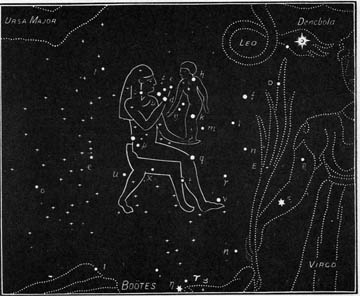
The Egyptian name for this decan of Virgo is Shes-nu, means "Desired Son," and the star picture of Coma is of a woman with a child in her lap. This correlates to the Biblical connotation of the sign, as we have already seen in the documentation of the specific signs of the Celestial Prelude. We find some related scriptural references to "the desired of the nations" in Haggai 2:7 and Numbers 24:17. Another decan of Virgo is Böötes, which in Egypt was called Smat, meaning the "one who rules," [Ps. 96:13]. The brightest star in Böötes is Arcturus, which is referred to in the book of Job 9:9. In one decan of the scorpion-Scorpius the Egyptian name for Ophiuchus is Api - Bau, meaning; the chief who comes. Another decan of the Scorpion is Hercules, shown below, which in the Egyptian is simply "Bau," meaning "who comes." This of course relates the Greek mythology of Hercules, like his 12 labors for instance, to the sufferings of the conquering King of kings-Jesus Christ. Some of these themes are evident in the graphic below, as the spear through Hercules' heel reflects the sufferings Christ endured, leading to his glorious victory over the enemy, depicted as he subdues the dragon under his opposite foot.
The decan of Hercules

We continue with the sign Sagittarius, whose Egyptian name was Knem, with the meaning "he who conquers." This is consistent with the Biblical theme of Jesus returning as the King of Kings, to conquer all forces of darkness. Another Egyptian word applied to this sign, Pi-Maere, tells of the graciousness of the power of God's righteous king. We find evidence of this theme in the first verse of the 45th Psalm.
Psalm 45:2-7
2 Thou art fairer than the children of men: grace is poured into thy lips: therefore God hath blessed thee forever.
3 Gird thy sword upon thy thigh, O most mighty, with thy glory and thy majesty.
4 And in thy majesty ride prosperously because of truth and meekness and righteousness; and thy right hand shall teach thee terrible things.
5 Thine arrows are sharp in the heart of the king's enemies; whereby the people fall under thee.
6 Thy throne, O God, is for ever and ever: the sceptre of thy kingdom is a right sceptre.
7 Thou lovest righteousness, and hatest wickedness: therefore God, thy God, hath anointed thee with the oil of gladness above thy fellows.
The Constellations Sagittarius and Capricorn
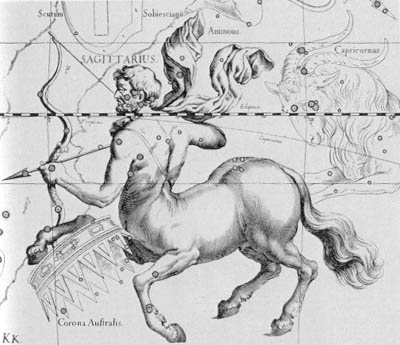
The fifth verse above clearly depicts the star picture found in Sagittarius, the great mounted archer whose arrows are trained on the star at the heart of the celestial Scorpion, Antares. In one decan of Sagittarius we find the Lyra, with its brightest star Vega, meaning he, the conqueror shall be exalted. Also in these decans we have Draco the serpent pictured under the feet of the conqueror's horse in the Dendera zodiac. This serpent is called Her-fent in the ancient Egyptian, meaning the serpent accursed. As we continue in with the sign Capricorn, in Dendera the name is Mu-penius, meaning; a place of sacrifice, rather than the sacrifice itself. For the sign Aquarius, Dendera pictures two urns consistent with the Arabian star name that has been preserved into modern times "Saad el Melik," or the record of pouring forth. The book of Isaiah gives details comparing the outpouring of water for the thirsty, [Pisces Australius] with the outpouring of holy spirit on His seed, relating to the sign Aquarius. [Joel 2:28-32, John 3:3-8, 4:10-16]
Isa. 44:2-6
1 Yet now hear, O Jacob my servant; and Israel, whom I have chosen: 2 Thus saith the LORD that made thee, and formed thee from the womb, which will help thee; Fear not, O Jacob, my servant; and thou, Jesurun, whom I have chosen. 3 For I will pour water upon him that is thirsty, and floods upon the dry ground: I will pour my spirit upon thy seed, and my blessing upon thine offspring: 4 And they shall spring up as among the grass, as willows by the water courses.
5 One shall say, I am the LORD'S; and another shall call himself by the name of Jacob; and another shall subscribe with his hand unto the LORD, and surname himself by the name of Israel. 6 Thus saith the LORD the King of Israel, and his redeemer the LORD of hosts; I am the first, and I am the last; and beside me there is no God.
One decan of Aquarius is the Southern Fish, whose name in Egyptian is Aar, meaning a stream. This of course refers to the stream of water poured from the urns of Aquarius, into the thirsty mouth of Pisces Australis. Speaking of fish, the Egyptian name for Pisces is Picot, which means the swarms or multitudes. This is significant when we realize that the two fishes of Pisces Biblically represent the 12 tribes of people in Israel and Judah. We find these truths expounded in the decan of Pisces called The Band, and the Biblical record in Hosea.
Hosea 11:1-5
1 When Israel was a child, then I loved him, and called my son out of Egypt. 2 As they called them, so they went from them: they sacrificed unto Baalim, and burned incense to graven images. 3 I taught Ephraim also to go, taking them by their arms; but they knew not that I healed them. 4 I drew them with cords of a man, with bands of love: and I was to them as they that take off the yoke on their jaws, and I laid meat unto them. 5 He shall not return into the land of Egypt, but the Assyrian shall be his king, because they refused to return.
Constellation Pisces with decan of the Band tied to the Neck of Cetus.
Also pictured here, right of the horizontal Fish-the Urn of Aquarius the Water-bearer.
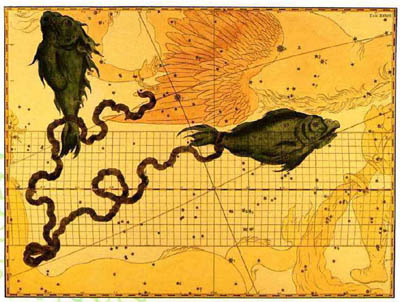
The word for the decan of The Band is U-or in Egyptian, meaning "he comes binding them together, and breaking the binding band." We can see this in verse four above, along with Ephraim in verse three, as one of the tribes of Israel represented by one of the two fish of the sign Pisces. The second decan of the fishes is Andromeda, known in Egypt as Set, meaning; seated as a Queen. This truth is recorded in Isaiah.
Isa. 52: 1-8.
1 Awake, awake; put on thy strength, O Zion; put on thy beautiful garments, O Jerusalem, the holy city: for henceforth there shall no more come into thee the uncircumcised and the unclean. 2 Shake thyself from the dust; arise, and sit down, O Jerusalem: loose thyself from the bands of thy neck, O captive daughter of Zion. 3 For thus saith the LORD, Ye have sold yourselves for nought; and ye shall be redeemed without money. 4 For thus saith the Lord GOD, My people went down aforetime into Egypt to sojourn there; and the Assyrian oppressed them without cause. 5 Now therefore, what have I here, saith the LORD, that my people is taken away for nought? they that rule over them make them to howl, saith the LORD; and my name continually every day is blasphemed. 6 Therefore my people shall know my name: therefore they shall know in that day that I am He that doth speak: behold, it is I. 7 How beautiful upon the mountains are the feet of him that bringeth good tidings, that publisheth peace; that bringeth good tidings of good, that publisheth salvation; that saith unto Zion, Thy God reigneth! 8 Thy watchmen shall lift up the voice; with the voice together shall they sing: for they shall see eye to eye, when the LORD shall bring again Zion.
As the decan of Andromeda is pictured in chains, so these chains will also be broken by the Coming Redeemer, and the captive daughter of Zion will sit down and reign as Queen. The third decan of Pisces is Cepheus, known as Pe-ku-hor, in Egypt, the one who comes the rule.
The decan of Cepheus the Crowned King
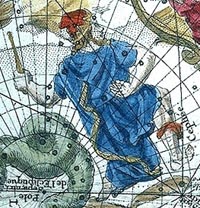
This not only corresponds with Cepheus as the crowned king, but also relates to the pole star Polaris residing between his feet [Eph. 1:20-23], signifying Christ's dominion over all Creation as seen in the precession of the poles. As we proceed to the decans of Aries, called in Egypt Tametouris Ammon, the rule of Ammon, we find Dendera's name for Cetus the Sea monster as Knem meaning the subdued, [Job 41:1-10, Isa. 26:21-27:1]. We find confirmation of this in Psalm 74.
Psalm 74:9-18
9 We see not our signs: there is no more any prophet: neither is there among us any that knoweth how long.
10 O God, how long shall the adversary reproach? shall the enemy blaspheme thy name for ever? 11 Why withdrawest thou thy hand, even thy right hand? pluck it out of thy bosom.
12 For God is my King of old, working salvation in the midst of the earth.
13 Thou didst divide the sea by thy strength: thou brakest the heads of the dragons in the waters.
14 Thou brakest the heads of leviathan in pieces, and gavest him to be meat to the people inhabiting the wilderness.
15 Thou didst cleave the fountain and the flood: thou driedst up mighty rivers.
16 The day is thine, the night also is thine: thou hast prepared the light and the sun.
17 Thou hast set all the borders of the earth: thou hast made summer and winter.
The heads of the Leviathan, the great sea-monster, are broken by the Hand of God, and its carcass is fed to the inhabitants of the land. The context of the waters referred to here, are much greater than the oceans of the Earth. As we can see in verses 16-17, the context is the Creation of the world, when God moved upon the faces of the great deep and said. Let there be light. It was the enemy who brought about the destruction of the First Heavens and Earth, as is recorded between Genesis 1:1-2. God created all things in His order, they only became "without form and void" as a result of the attempted coup and revolt of the dragons in the waters, who put the darkness on the faces of the great deep. God restored His order in the creation record of Genesis 1, including the great lights of the firmament that separated the waters above it, from the waters inside it [Gen. 1:6-8], after He divided the light of Day from the darkness of Night. He also set the borders of these celestial lights in the order of the Earth's cycle of Day and Night [v. 16-17], where the order of the Solstice provides the longest days and shortest nights in the north and southern hemispheres, of our planet Earth. The dragon's power is great, but the power of our Heavenly Father is greater than the entire realm of evil spirits, and He has given us the fullness of this power in His only begotten Son Christ Jesus. As we wield this spiritual power, we exercise our true supernatural Christian authority over the powers of the darkness of this world. We can see hints of this in the next decan of Aries, called Perseus the breaker, known as Kar Knem, he who fights and subdues. When we come to Orion the Egyptian word is Hag-at, or he who triumphs. No matter the trials that we endure in this world, our ultimate victory is guaranteed by God, as we stay faithful to His Son Jesus Christ.
Orion from Hevelius with the River Eridanus proceeding from his Foot-Star
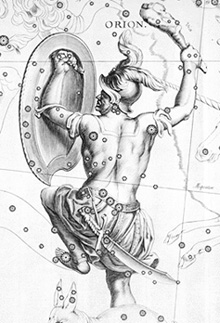
The next decan depicts the great celestial river that proceeds from Orion's foot, down to the nether parts of the underworld located in the southern polar reaches. The Egyptian word for Eridanus is Peh-tat, meaning; the mouth of the river that comes out of the foot of Orion.
In Gemini we find an interesting idea in support of the Biblical theme of this sign. Instead of the twins of which we are familiar, the original message teaches of the redeemer's sufferings and glory, the dual nature of his prophecies both in Scripture and the Stars. The Egyptian word for Gemini is Claustrum Hori or the place of he who comes. This refers to the glory of the Coming Redeemer, something that is lost in the modern vernacular of this sign. As Joseph Seiss also points out:
"In the zodiac of Dendera, the figure [of Gemini] is that of a man walking hand in hand with a woman. The same are sometimes called Adam and Eve. But the male figure is not the literal first Adam, but the mystic second Adam the same seed of the woman who everywhere appears in these celestial frescoes. And having identified the masculine figure, there can be no difficulty in identifying the accompanying female figure. The Lamb has a Bride, a wife, bone of his bone and flesh of his flesh, and destined for an everlasting union with him in glory and dominion."7 [emphasis & brackets mine]
As we have noted the dual significance of the celestial gospel message, first in the shorter annual cycle of the Sun through the ecliptic, and secondly pertaining to the longer precessional cycle, so we should recognize this pattern relating to Gemini. I agree with Siess' conclusion that Jesus Christ, the second Adam is referred to predominantly in reference to the promised seed in the zodiac, linked with the Sun's shorter annual cycle through the year. However, the reference to the first Adam in the Garden of Eden with Eve, fits very well with the precessional cycle, seen as the Age of Gemini preceding the Age of Taurus in the precession of the equinoxes. Eve was the forerunner of Israel, the Bride of Christ, for whom the Lord laid down his life in sacrifice. The structure of Dendera's zodiac puts the Age of Gemini in the early stages of the progression of precessional ages, preceded by Sirius-seen as a reclining cow with a bright star between its horns overhead. This relates to the time before the Garden of Eden, during the First Heavens and Earth when the Angels of God occupied their First Estate [Job 38:4-7, Jude 6], led by Lucifer the Archangel of light, prior to his fall [Isa. 14:12, Gen . 1:1-2]. We have covered the relevant Biblical Astronomy symbolism of Sirius, and its relation to Orions' Belt stars, also called the "Navigator's Line" [Job 38:12-15], in other studies of this website. The reader can review my studies on The Calendar of the Biblical Patriarchs, under the Menorah section of the article for more details.
Canis Major is a prominent decan of Gemini, whose brightest star Sirius, the brightest star in the heavens, bears the Egyptian word Apes, carrying the idea of the Head. This establishes the dual meaning of this word found in the Hebrew text of Job 38: 12-15, and provides the basis of the Sirius or Sothic Calendar in Egypt that we have already studied. As we take note of the both the annual and precessional aspects of the celestial gospel, new insights will open to the student of God's Word written in the heavens.
In summary, as we come upon the last book of this Egyptian celestial scroll, Leo the lion bears the Egyptian name Pi-Mentikeon which tells the message of pouring out the divine wrath. Another Egyptian word referring to Leo is Aryo, the rending Lion, which is made plain in Job 38.
Leo the Lion rending Hydra the Serpent Destroyed
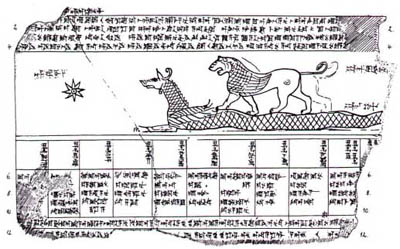
Job 38:39-41. 39 Wilt thou hunt the prey for the lion? or fill the appetite of the young lions, 40 When they couch in their dens, and abide in the covert to lie in wait? 41 Who provideth for the raven his food? when his young ones cry unto God, they wander for lack of meat.
This section of the book of Job also reveals the decan of Leo called Corvus the Raven who, as we have seen, with the other carrion-eaters and birds of the field, feasts upon the carcass of Hydra the serpent destroyed. With the last sign of the Biblical zodiac, confirming the witness of the stars that God installed in them, the Astronomy of ancient Egypt speaks loudly in support of both the Scriptures and the heavens, as they declare the Coming Redeemer of Mankind and the glory of God. [Psalm 19:1]
As we began this study in Virgo and wrapped it up in Leo, we see one purpose of the Great Sphinx, formed as the head of Virgo the Woman, and the body of Leo the Lion- the alpha and omega of the celestial scroll, witnessing to the promised seed of mankind as the first and last way [alpha & omega] of redemption provided by the Creator.
With the witness of the other monumental elements of the Giza Plateau in unison with this record, we are afforded a most powerful testimony of the Creator's application of His Intelligent Design principles that He incorporated into His Creation. Even the fool can see the undeniable witness of His Omnipotent power, as Paul tells us in his epistle to the Romans.
Romans 1:19-23
19 Because that which may be known of God is manifest in them; for God hath showed it unto them. 20 For the invisible things of him from the creation of the world are clearly seen, being understood by the things that are made, even his eternal power and Godhead; so that they are without excuse: 21 Because that, when they knew God, they glorified him not as God, neither were thankful; but became vain in their imaginations, and their foolish heart was darkened. 22 Professing themselves to be wise, they became fools, 23 And changed the glory of the uncorruptible God into an image made like to corruptible man, and to birds, and fourfooted beasts, and creeping things.
The preceding discourse has plainly shown the obvious parallels between the themes and star names of the ancient Egyptian and Hebrew Zodiacs. This evidence stands on its own in support as a powerful witness to the themes of Biblical Archaeo-Astronomy and the Celestial Gospel. But this is not the whole story concerning the Dendera zodiac. As is the case with any zodiac or star map, the axes of the Cardinal Directions must be given to provide us our bearings. It is the lines of the equinox and Solstice, that always show us the 4 points of the compass to the North, South, East and West. Recognition of the axes of the Dendera zodiac provides even further evidence in support of our case, along with some unexpected eye-opening revelations. Lets take a closer look at these axes.
The Axes of the Dendera zodiac
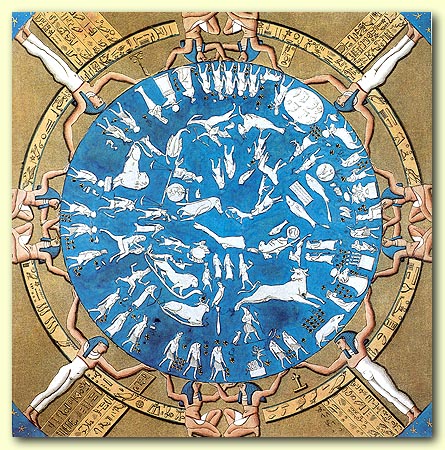
The foregoing narrative has focused primarily on the Sun's annual cycle through the 12 houses of the ecliptic during the year. This record of the clockwise motion of the Sun is one level of truth related in the Celestial Gospel, but there is more. As we mentioned above, there is strong evidence that the ancient Hebrews and Egyptians were also aware of the slower precession of the equinoxes reflecting a knowledge of the Sun's longer counter-clockwise motion through the ecliptic. The Dendera zodiac provides facsinating proof of this, corroborating the themes already expressed in the Sun's annual cycle. This structure is intended as a check and balance of sorts, supporting what we have already learned in the witness of the shorter timeframe of the year. The Sun's precessional movement is highlighted by which sign of the zodiac it rises in at the spring equinox. For the last 2000+ years it has been in Pisces, thus we are presiding in final years of the Piscean Age according to the Sun's precessional movement. The following chart shows how the precessional ages would correlate to the Biblical Administrations, revealing a consistent progression of themes as God's Plan of the Ages unfolds. This provides the overarching context for the plan of redemption and restoration of Mankind, through the redeeming work of Christ-the centerpiece of the the Ages. Our TIMELINE section on the web-site goes into greater detail, explaining the significance of these age-times in God's Plan.
Precessional Ages Aligned with Biblical Administrations
| Zodiacal Sign |
Biblical Administrations |
Heavens & Earth |
Start Dates |
Scripture |
| Sirius |
Angels First Estate |
First |
|
Gen.1:1-2 |
| Gemini |
Original Paradise |
Second |
6480 BC |
Gen. 3:8ff |
| Taurus |
Bible Patriarchs |
Second |
4320 BC |
Gen. 3:23ff |
| Aries |
O.T. Law |
Second |
2160 BC |
Ex. 19:16ff |
| Pisces |
Christ/Grace/Revalation |
Second |
7BC-now |
Matt. 3:11ff
Acts 2:1ff
IThess. 4:13 |
| Aquarius |
Final Paradise |
Third |
2153 AD |
Rev. 21 |
This march of the precessional ages is recorded in the Dendera zodiac, in a recognition of the axes built into its structure. The primary axes of the Dendera zodiac are indicated in the graphic below, from Schwaller De Lubicz' seminal analysis of this zodiac, showing the coordination of the precession of the poles with the precession of the equinoxes. As the pole star recedes from the star Thuban of Draco to the current pole, in Polaris of Ursa Minor [little bear] in the center of the graphic, we can see the corresponding precessional ages/years BC marked on the outer circle. The fact that the ancient Egyptians recognized these two poles and their inter-relationship itself, bespeaks a knowledge of the precession phenomea. The role and Biblical Archaeo-astronomical approach to this subject, in one sense, will separate the symbolic details associated with the idol entites of the Egyptian Star Religion, which corrupted the original unity they shared with the Hebrew Star names, that we have just witnessed in the preceding section.
Astrology as had a vast corrupting influence on the idea of the precession of the equinoxes. By idolizing the zodiacal signs and blurring the link between the shorter clockwise, and much longer counterclock-wise solar cycles, Astrology not only lacks the ability to accurately distinguish when one precessional age ends and a new age begins, but a clear concept of the relationship between these two zodiacs [tropical and sidereal] is totally lacking of any standard, and no astrologer can agree as to when these two zodiacs were first coordinated "in synch," so to speak. They are thus left in a free-for-all to subjectively determine their own systems according to whatever point they choose to emphasize. This has led to chaos and confusion where divine celestial truths have been obscured. As the Sun moves on the ecliptic during the solar/ tropical year, it moves through the backdrop of "fixed" stars [sidereal zodiac]. These two must be understood BOTH as separate celestial zodiacs, and together in a unified system. The annual solar year lacks meaning without the context of the stellar backdrop of the sidereal zodiac. On the other hand, the very long stellar zodiac lacks an application to men's everyday lives associated with the shorter annual Sun cycle. As in the chart above, once the Biblical Administrations are tied to these celestial zodiacs, along with the related precessional ages, their Biblical import is clarified, and the purpose of the Heavens in God's Plan for the Ages is revealed.
Once we adopt the understanding and perspective of the Biblical Patriarchs in the context of God's Plan to restore the Ages, we uncover the divine perspective, which has been hidden under the debris of man's dilapidated idols in ancient history. As we recognize the story of the Coming Redeemer written in the heavens, at the root of all cultural sky myths, we can unearth the primal secrets and original symbolic truths of the celestial gospel in every culture, thus decoding the world monomyth.
Overlaid Zodiacs of the Celestial Pole and ecliptic Pole of Dendera
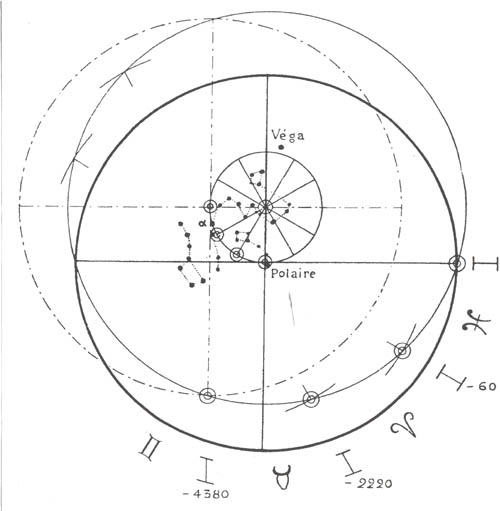
As we can see in the graphic above, the receding pole star is mapped on the smaller inner circle, along a series of four points corresponding to four points on the larger outer circle of the zodiac. This shows us the pole star in the specific precessional ages going back to the Age of Gemini, marked on the larger zodiacal circle by the symbol "II", prior to 4380 BC, showing the transition from the Age of Gemini to the Age of Taurus. This depicts that Gemini stands at the early stages of Egyptian reckoning of precessional ages in Dendera's zodiac, even though the latest version of the Temple of Dendera housing this zodiac, was rebuilt in the late Hellenistic period. As the outer circle progesses in a counter-clockwise movement, we come next to the sign of Taurus the Bull, marked by one of the main axes of the larger circle in solid lines above. On the full circle of the zodiac, Scorpius is directly across from Taurus, forming one of the main axes, while Leo the Lion is across from Aquarius forming the other. This gives us a picture of the main zodiacal axes during the precessional Age of Taurus, as marked by the axes of the Dendera zodiac above. We find the Biblical correspondence to this in Numbers 24.
Numbers 24:7-9
7 He shall pour the water out of his buckets, and his seed shall be in many waters, and his king shall be higher thean Agag, and his kingdom shall be exalted. 8 God brought him forth out of Egypt; he hath as it were the strength of a unicorn: he shall eat up the nations, his enemies, and shall break their bones, and pierce them through with his arrows. 9 He couched, he lay down as a lion, as a great lion: who shall stir him up? Blessed is he that blesses thee and cursed is he that curses thee.
Here we see the Biblical recognition of the same celestial axes mapped out in the Dendera zodiac. Numbers 24:7 refers to Aquarius' water buckets, at one end of the axes, whose other end is occupied by Leo, the Great Lion seen in verse 9. Verse 8 refers to the Unicorn [reem] which means the wild bull of Taurus, opposite the Scorpion on the second main axis. The context of Numbers 24 lays out the the tents and tabernacles of Israel [Num. 24:5] as the pattern of the 12 tribes of Israel mapped out in correspondence to the 12 signs of the Biblical zodiac.
In his work Skies of Memory, John Lash summarizes evidence he found of the ancient Egyptian awareness of precession as follows:
"The [Dendera] zodiac has 2 North poles: one located in the Jackal, known to us as the Little Bear, and the other in Tu-art, the Hippotamus, known to us as Draco, the celestial Dragon. There are two poles because,as we know, the earth's axis is tilted 23.5 degrees relative to its plane of motion around the Sun. The North pole points currently to the Jackal as at Dendera, but not to precisely the same place in the Jackal. This is because the terrestrial axis slowly rotates around the axis of the earth's orbital plane, ever centered in Draco. This long-term wobble marks the cycle of 25,920 years. The inclusion of both poles in the Dendear zodiac may be plain evidence that precession was known to the ancient Egyptians."8
The Hippopotamus at the North Pole referenced by Lash, is pictured below with a crocodile riding his back, reminiscent of the description of Behemoth in Job 40 and Leviathan in Job 41. As these figures are symbolically identified with Draco, their description and astronomical function comes to light.
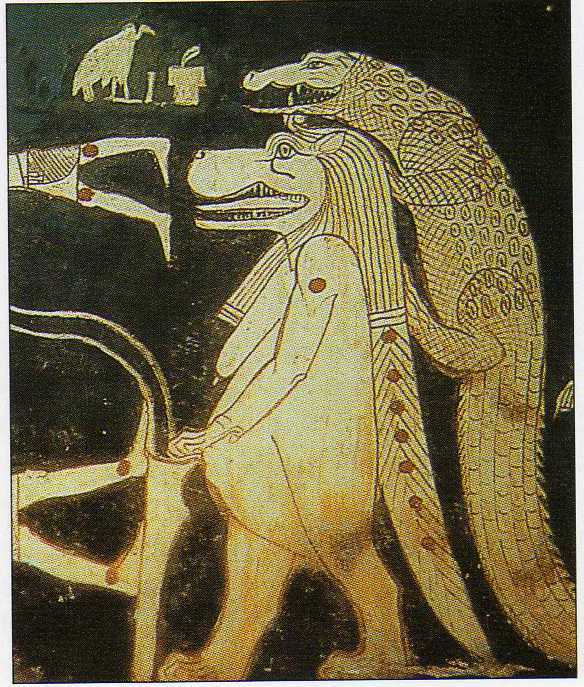
Lash was not alone in making reference to the axes of the Dendera zodiac, As mentioned above, Schwaller De Lubicz is another scholar who argued in favor of the Egyptian knowledge of precession. He points out 2 hieroglyphs on the outer rim of Dendera's zodiac that mark a line between Aries the Ram and Taurus the Bull, which correlates to a date around 2100 BC, indicating how the Egyptians wanted to mark the transition in precessional ages, in this case from the age of Taurus to that of Aries. "The mere fact that the cult of the Bull [Apis/Mentu] preceded the cult of the Ram [Amon] in Egypt, and that the dates of these cults correspond to the equinoctial positions of their constellations at the appropriate time-approximately 4000 and 2000 BC-is conclusive"9 according to Schwaller DeLubicz, that the ancient Egyptians were aware of and applied their knowledge of precession. Lash continues this line of easoning on Dendera's axes as follows:
"As I studied the overall design of the zodiac I realized there was a 5th, as yet undetected axis. My attention was first drawn to its presence by the figure of Virgo the grain goddess identified with Isis, who holds up a stalk of wheat in a gesture known from Sumerian sources as early as the third millenium BC."10
We should recognize Virgo's wheat stalk as her brightest star, known today as Spica, but in the Hebrew as [Al Zemach] meaning the branch which is one of the prominent titles of the Promised Seed, or offspring of God, in the Old Testament [Jer 23:5-6]. What is unique about this as it relates to Dendera's zodiac is that Spica/Al Zemach is only one of two individual stars marked on this entire star map, the other being Sirius. As Lash further elaborates on this point:
"Sirius, is placed between the horns of the sacred cow on axis B, and Spica, the star traditionally identified with Virgo's sheaf of wheat. This led me to wonder what an axis inscribed from Spica through the Jackal pole would look like..."11 Lash makes note of some specific observations in connection with what we can refer to as the "Spica Axis" on Dendera's zodiac that are worthy of our attention:
"First, the axis culminates by bisecting the altar mounted by 4 ram's heads situated on the periphery of the zodiac. This seems to interlock its internal features, represented by the solar zodiac of ecliptic Constellations, with the lunar pattern of decans, 10 degree divisions of the Moon's orbit running around the periphery. Second, Axis E [Spica axis] crosses Pisces at the tail of the lower or foremost fish exactly where the spring equinox occurs today. Third, Axis E, extended to Virgo's feet marks the tail of Leo at a point that corresponds by precession to 10,500 BC. All in all, axis E marks the moment of precession when one full cycle ends and a new one begins."12 [brackets & bolds mine]
The first observation Lash points out makes reference to is the recognition that the Spica axis bisects the Ram altar on the periphery of the zodiac. This points out clearly the correlation between Spica/Al Zemach and the altar of sacrifice that the Promised Seed would endure to pay the price for forgiveness of sins, that only Christ could pay for all mankind. Lash also refers to the Luni-solar year on this ancient Egyptian star map. This provides additional evidence that these ancient astronomers were not only aware of precession, but also a coordinated luni-solar year far in advance of what was previously thought by historians. This also fits with the use of the Sothic Calendar, based on the star Sirius, first in Egypt, showing why they would chose to designate Sirius on their star map. Lash elaborates on his second observation as follows:
"As the total pattern came into focus, I recognized that axis E signals this moment of epochal transition in a vivid intentional way. Whoever designed Dendera was looking ahead in time to our age, when the spring equinox occurs under the tail of the western fish, because this is the time that the entire cycle culminates. With the spring equinox just at that position in Pisces, the axial cross locks into unique alignment with the Galaxy".13
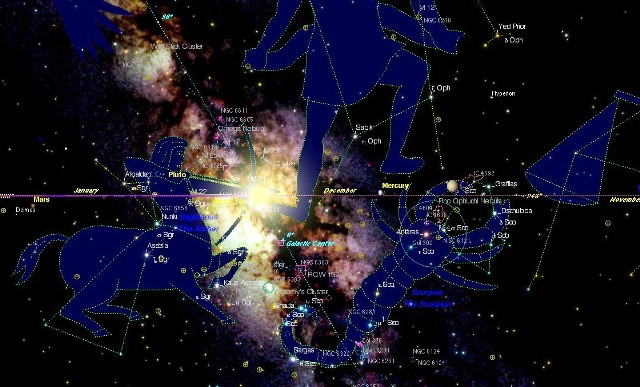
This comment by Lash indicates not only the precessional awareness of these ancient astronomers, but also how the precession of the equinoxes provides a window into this galactic alignment. We can see further evidence of this, in the axis indicated by Schwaller De Lubicz between Taurus and Aries. As this axis extends through the otherside of the zodiac, it brackets Sagittarius and Scorpius in the central point of the Milky Way Galaxy, where the tip of the Horseman's Arrow trains his aim into the dark rift of the galactic heart, as seen in the graphic above. To be clear on this point, the axes of the Dendera zodiac seem to be designed to point any learned observers attention to the importance of Spica/Al Zemach and Sirius in decoding this star map. Relating to Spica it is apparent that the axis is pointed towards the Age of Pisces, whose inception witnessed the birth of Jesus Christ the Promised seed, marked by 2 rare triple planetary conjunctions both involving Jupiter. The culmination of the Piscean Age is marked also by this axis, at the other end of Dendera's zodiac marking Sagittarius and Scorpius, pictured above in December 21st, 2012, even as it is marked by the Mayan astronomers, as the end of their 5th Age. This is an obvious eye-opener, which is further corroborated by Lash below!
As Lash points out, the precessional half cycle of 12,960 years back in history from today, brings us to 10,500 BC. In fact Lash believes that Spica was designed among other things, to act as a pointer towards this galactic alignment as seen in his following summation:
"Spica, which I call the precessional star, seems to be the master key to the Dendera zodiac. Axis E [Spica axis] reveals an infrastructure based on galactic features only thought to have been known in recent times. If my inferences are correct, Dendera proves not only that precession was known and applied to a scheme of World Ages, but that the entire 26,000 year cycle was understood in its formal organization."14 [brackets mine]
The fact that this study of the axes of the Dendera zodiac lead us directly to the timing of Christ's birth at the inception of the Age of Pisces alone, is worth the price of admission. The details of the celestial signs leading up to the birth of Christ are covered in our website study on the "Celestial Prelude" which is found under the Biblical Astronomy of the Birth of Christ section of this site. The Significance of Jupiter-Saturn triple planetary conjunctions are laid out there, along with how these Conjunctions were also central to Mayan Astronomy. The Dendera zodiac as a prominent artifact of ancient Egyptian archaeology provides an independent witness to the principles of Biblical Archaeo-Astronomy, but when combined with the witness of the Great Sphinx and the Great Pyramid their collective chorus becomes almost deafening to those who have ears to hear.
As we allow the heavens to have their say in declaring the manifest glory of the Creator, we will avoid the pitfalls of those throughout history, who decided to rather change the glory of the incorruptible God into any form found in Creation, be it man, animal or insect. Let's learn our lessons from the Egyptians who stumbled on this downward path away from God's Grace, into His wrath and fiery judgment in the age of Moses.
FOOTNOTES:
3. Echoes of the Ancient Skies, E.C. Krupp. p. 172
4. Strong's Concordance
5. Secrets of the Great Pyramid, Peter Thompkins, p.168
6. Witness of the Stars, EW Bullinger
7. Gospel in the Stars. Joseph Seiss. pg. 113
8.The Companion Bible, E.W. Bullinger. Appendix 42.
9. The Skies in Memory, John Lash as quoted in The Atlantis Blueprint, Wilson & Flem-Ath. p. 169
10. Secrets of the Great Pyramid, Peter Thompkins ppg.169-172.
11. The Skies in Memory John Lash as quoted in The Atlantis Blueprint p. 170
12. IBID
13. IBID p. 171
14. IBID
15. IBID p. 172
|
